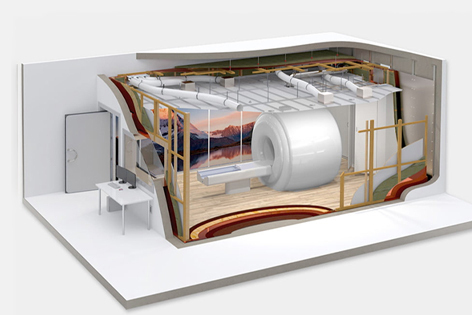MRI machines use radio-frequency (RF) to create images and so they have highly sensitive RF sensors. These sensors can pick up the radio-frequency electromagnetic radiation (RF noise) coming from outside of the MRI exam room. The potentially interfering RF noise comes from a wide variety of common electronic devices, such as transformers, motors, computers, and even cardiac monitors.
If the MRI exam room does not have an effective RF shield, then the incoming RF waves may affect the MRI’s imaging.
The ceiling, walls, doors, and windows in this image all work together to provide an effective shield.

To prevent this distortion, an RF shield enclosure features a “system” of interacting components, including:
- Doors
- Windows
- Ceilings
- Floors
- Walls
Additionally, items penetrating the RF shield (power, HVAC, exhaust, piping, and plumbing) must pass through RF filters or waveguides.
All of these components work together to provide a functional shield barrier that reduces RF noise to acceptable levels.
MRI machines use radio-frequency (RF) to create images and so they have highly sensitive RF sensors. These sensors can pick up the radio-frequency electromagnetic radiation (RF noise) coming from outside of the MRI exam room. The potentially interfering RF noise comes from a wide variety of common electronic devices, such as transformers, motors, computers, and even cardiac monitors.
If the MRI exam room does not have an effective RF shield, then the incoming RF waves may affect the MRI’s imaging.
The ceiling, walls, doors, and windows in this image all work together to provide an effective shield.

To prevent this distortion, an RF shield enclosure features a “system” of interacting components, including:
- Doors
- Windows
- Ceilings
- Floors
- Walls
Additionally, items penetrating the RF shield (power, HVAC, exhaust, piping, and plumbing) must pass through RF filters or waveguides.
All of these components work together to provide a functional shield barrier that reduces RF noise to acceptable levels.
